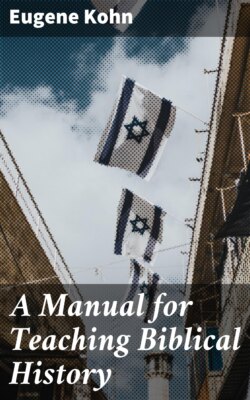Читать книгу A Manual for Teaching Biblical History - Eugene Kohn - Страница 7
На сайте Литреса книга снята с продажи.
CREATION
Genesis 1.1 to 2.3
ОглавлениеTable of Contents
Note.—The lessons in this book are necessarily divided somewhat arbitrarily, that is without exact reference to the amount that can be taught at a single session of the school. This is unavoidable at present as periods vary in length in different schools, and classes vary in age and in the mental development of their pupils. The division therefore has been purely on the basis of the subject-matter and not of the time to be spent in instruction. Some lessons may require two or even three hours for their complete presentation.
Interpretation. The early narratives of Genesis serve as an introduction to Biblical history by giving the Jewish view of the origin of the world in general and the human race in particular, preparatory to discussing the role that Israel was destined to play in the world. The following are some of the most significant ideas that the narrative of the creation has to tell us with regard to the world and man's place in it:
1. That God is the creator and consequently supreme over matter, nature and the world;
2. That man is the highest being in the order of creation by reason of his being possessed of the divine attributes of reason and conscience as intimated in the words "in our image according to our likeness";
3. That God loves His creatures הָרַחֲמִים בְּמִדַּת שֶׁבָּרָא "whom he hath created in accordance with the attribute of mercy;"
4. That God in return desires man's love and his recognition in worship as is implied in the institution of the Sabbath.
Aim. In teaching this lesson to the child the aim should be to inspire him with the sense of reverence and worship, particularly in connection with Sabbath observance. The message of this as of all the earlier chapters of Genesis is a universal one, but, like most other universal aspects of Judaism, it has found concrete expression in a specifically Jewish institution, namely the Sabbath, and, as our aim is to affect the Jewish life of the child it is through association of the ideas of the lesson with the institution of the Sabbath that we must endeavor to make them effective.
Suggestions to the teacher. In accordance with the principle which demands that we proceed from what is known to what is not yet known, it at once becomes apparent that we cannot begin this lesson with an account of primal darkness out of which chaos and then the world was formed. In the introduction (page 22) we quoted an account of creation which began by a reference to created objects in the child's experience. In consideration however of the desirability of stimulating the child's intellectual curiosity before beginning the lesson, it would be well to introduce the lesson with a few questions regarding the distinction of the Sabbath from the other days of the week, culminating in the question, "Why do we act so differently on the Sabbath than on other days?" Then proceed to answer by telling the story of creation in the way suggested in the introduction. When the narrative is completed, again discuss the Sabbath and how it is to be observed, as in this way the moral of the narrative can best be enforced.
It is a well known fact that children are attracted by the exact repetition of certain phrases somewhat in the nature of a refrain. It is well therefore to utilize the refrain, "And there was evening and there was morning" with each of the successive days of creation.
